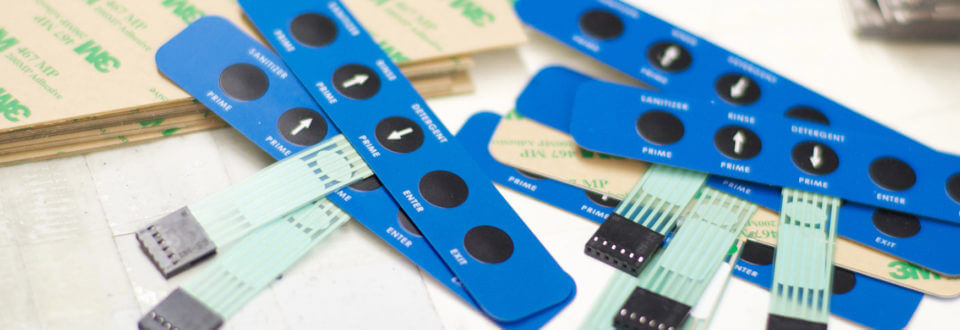Why a Membrane Switch Is Ideal for Industrial and Medical Applications
Why a Membrane Switch Is Ideal for Industrial and Medical Applications
Blog Article
Understanding Membrane Layer Switches: The Key to Reliable and sturdy Controls
Membrane layer switches represent a critical aspect of modern interface layout, blending performance with resilience in different applications. These versatile components not only facilitate user communication but are also crafted to withstand the roughness of demanding environments, from medical gadgets to commercial equipment. Comprehending their building and construction, operation, and the myriad benefits they supply is essential for designers and designers alike. As we check out the complexities of membrane switches, it becomes clear that their role in enhancing control systems is both extensive and complicated, increasing inquiries about how finest to utilize their abilities in future technologies.
What Are Membrane Layer Buttons?
Membrane buttons are a sophisticated option in the world of individual interface modern technology, incorporating performance and style effortlessly. These tools function as a user interface in between customers and digital systems, integrating several parts right into a portable format. Usually created from adaptable, slim layers of products, membrane layer buttons are made to react to touch, enabling users to communicate with machinery and electronic gadgets successfully.
The main components of a membrane layer button include a printed circuit layer, graphic overlay, and a spacer layer that protects against unintentional activation. The visuals overlay can be customized to mirror brand identification or customer preferences, boosting aesthetics while making certain functionality. Membrane buttons are frequently made use of in various applications, consisting of medical gadgets, consumer electronic devices, and commercial tools, owing to their sturdiness and resistance to ecological elements such as wetness and dust.
Among the key advantages of membrane buttons is their ability to stand up to wear and tear, making them excellent for high-traffic environments. Furthermore, they are light-weight and call for minimal room, enabling innovative layouts in item advancement. Overall, membrane switches stand for a functional and effective option for contemporary electronic user interfaces, marrying technology with user-centric layout principles.

Exactly How Membrane Switches Work
The procedure of membrane layer changes joints on a basic yet effective device that converts individual input into digital signals. When a user presses the button, the top layer deforms, permitting a conductive aspect in the circuit layer to make contact with an equivalent conductive pad on the bottom of the graphic overlay.
The layout of membrane switches can differ, but they often include domes or tactile components to supply feedback to the customer, improving the overall experience. The materials used in membrane layer switches, such as polyester or polycarbonate, contribute to their sturdiness and resistance to environmental elements, consisting of wetness and dust. The printed circuits are commonly enveloped, which safeguards them from wear and tear over time.

Benefits of Membrane Buttons
Among the key benefits of membrane switches is their versatility in design, allowing them to be tailored to meet specific user needs and visual demands. This flexibility encompasses numerous markets, where various shapes, dimensions, and shades can be utilized to improve user communication and visual allure.
Additionally, membrane layer switches are understood for their toughness. Constructed from durable materials, they are resistant to dirt, moisture, and physical wear, which dramatically prolongs their life-span compared to typical mechanical switches. This longevity makes them especially ideal for high-traffic environments and applications calling for longevity.

Furthermore, membrane switches supply a structured account, causing a thinner style that can be integrated right into different devices without including bulk. This feature not just improves the visual charm however also adds to a much more ergonomic product design.

Applications of Membrane Layer Switches
User-friendly and flexible, membrane buttons find applications across a vast array of markets, including medical tools, consumer electronics, and commercial tools. In the medical field, these buttons are indispensable to devices such as diagnostic tools, patient tracking systems, and mixture pumps, where integrity and ease of cleaning are essential. Their ability to hold up against extreme environments and preserve performance makes them ideal for such applications.
In consumer electronic devices, membrane switches are made use of in products like microwaves, cleaning devices, and push-button controls - membrane switch. Their sleek layout permits user-friendly individual interfaces, boosting the total customer experience while giving sturdiness and resistance to use and tear
Industrial equipment also takes advantage of membrane buttons, specifically in control panels for equipment and automation systems. These buttons use security against dust and moisture, here are the findings guaranteeing consistent performance in challenging atmospheres. Their customizable attributes enable suppliers to customize them to certain functional requirements, improving effectiveness and capability.
Picking the Right Membrane Layer Switch
When picking a membrane layer button, it is necessary to take into consideration numerous variables that influence efficiency and viability for particular applications. The main considerations include environmental problems, responsive responses, longevity, and style requirements.
First, evaluate the operating atmosphere; buttons exposed to moisture, chemicals, or severe temperature levels call for specific products to make sure durability and functionality. Next off, assess the requirement for tactile responses. Relying on customer interaction, some applications might gain from a tactile response to validate activation, while others might choose a non-tactile layout for visual reasons.
Toughness is one more crucial element; membrane buttons website here must be created to stand up to frequent use, effects, and abrasion. Make sure the selected switch can sustain the anticipated lifecycle, especially in high-usage circumstances.
Final Thought
In conclusion, membrane layer changes serve as necessary elements in the design of sturdy and reliable control systems across various sectors. The adaptability of membrane switches over enables for tailored remedies that satisfy specific functional needs, enhancing their relevance in modern innovation.
Membrane switches stand for an important aspect of modern-day user interface style, mixing performance with resilience in numerous applications.Membrane buttons are an innovative option in the realm of customer interface innovation, combining performance and design flawlessly. Normally created from flexible, slim layers of products, membrane buttons are created to respond to touch, making it possible for users to engage with equipment and electronic gadgets effectively.
The style of membrane layer switches can vary, yet they typically include domes or tactile aspects to give feedback to the individual, boosting the overall experience.In verdict, membrane layer switches serve as crucial components in the style of use this link reliable and long lasting control systems throughout different markets.
Report this page